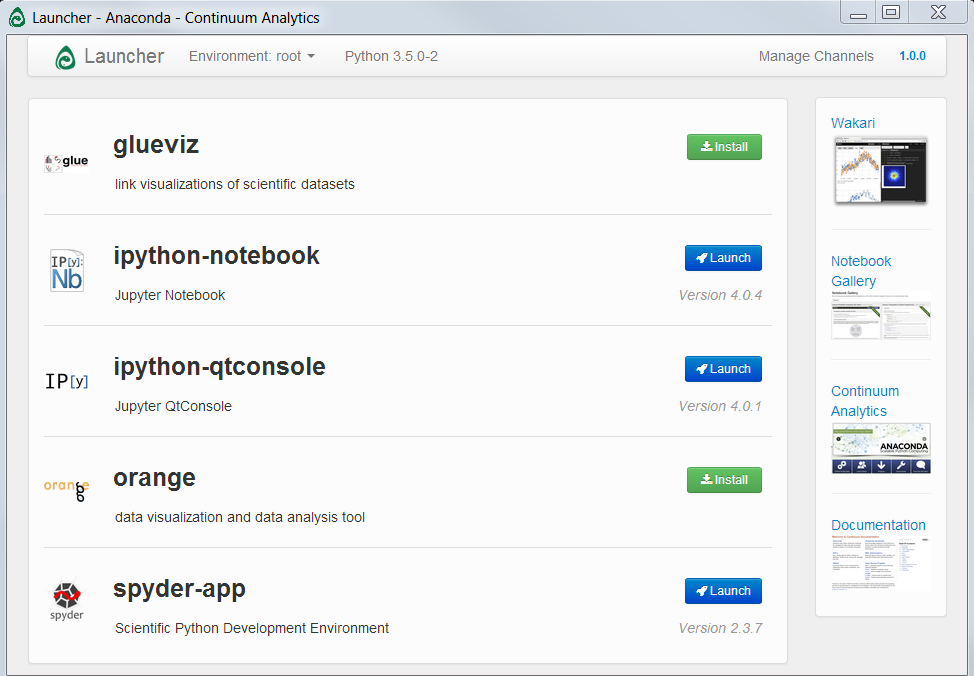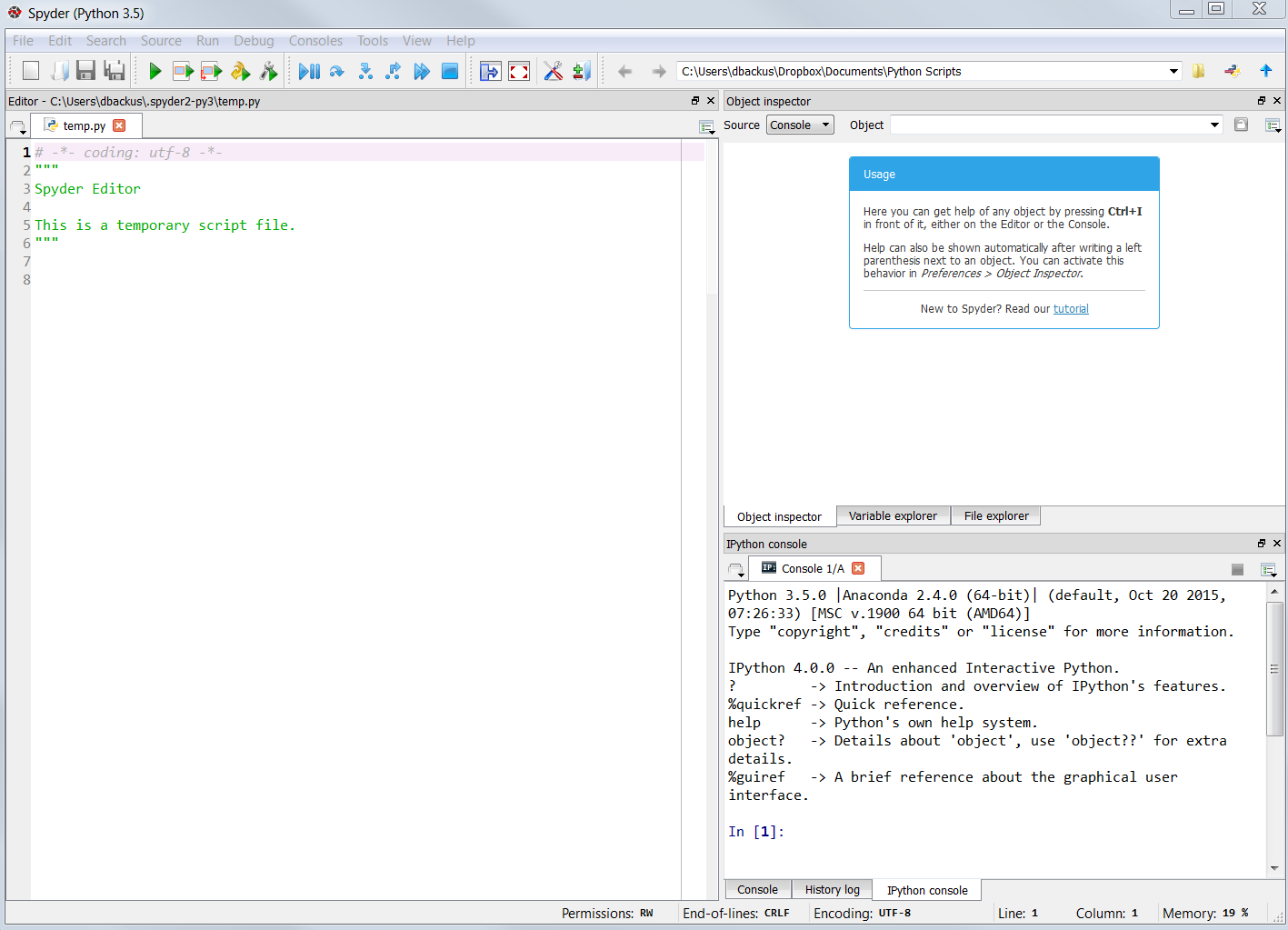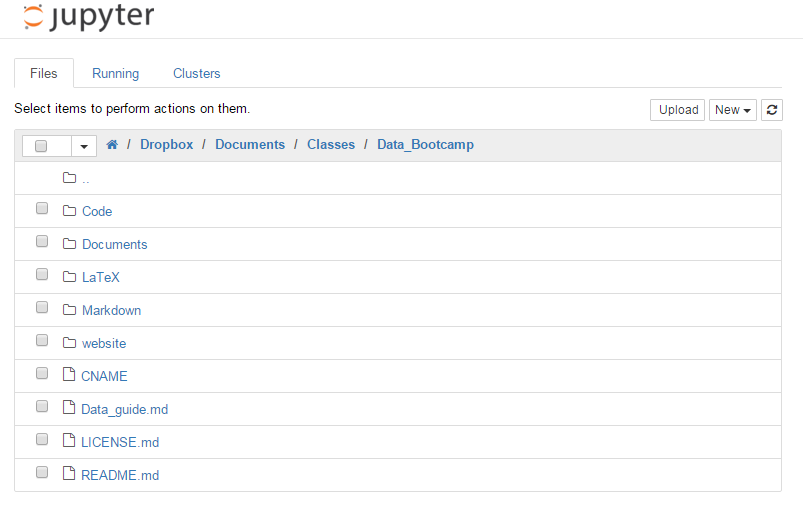Installing Python
Overview. We install Python, then run a test program to make sure it's working.
Python tools. Anaconda distribution, Spyder and IPython/Jupyter coding environments.
Buzzwords. Package, distribution, environment, mtwn.
Code. Python | IPython notebook.
Python is a programming language. Like other computer languages, it comes with an ecosystem of related components. We refer to collections of components as distributions. We're going to use a specific distribution -- Anaconda -- that comes with lots of components in one user-friendly download.
One kind of component is a user-interface or environment for writing and executing code. Here's an analogy: Word and Google docs are "environments" to produce text documents. Both work. We can use either one. The same is true of Python environments; we use the one we find most convenient. Think to yourself: An environment is analogous to Microsoft Word and a Python program is analogous to a Word document.
We'll use two Python environments in this class:
Spyder is a graphical interface that includes an editor, a button to run code, and windows for experimenting and checking documentation.
Jupyter is a browser-based interface for running IPython notebooks, which combine code, output, and documentation.
We will write and run Python programs in both environments.
This is a lot of jargon to swallow at one time. Don't panic, it will become familiar with use. And anything we don't use you can safely ignore.
Installing Anaconda
Follow these instructions. By which we mean: follow these instructions exactly! Creativity is a wonderful thing, but here it will cost you dearly.
Step 1. Download the Anaconda installer.
- Click HERE or Google "Anaconda downloads."
- Scroll to find "Anaconda for Windows" or further down for "Anaconda for OS X."
- Find the option for Python 3.5. NOT Python 2.7! If you get 2.7, you'll have to start over.
- Click the 64-bit Graphical Installer to start the download.
Step 2. Run the installer. Click on the Anaconda installer you just downloaded to install the Anaconda distribution of Python. Do what it says.
Step 3. Find and run Launcher. Look wherever programs are on your computer.
- Windows: Click on the Start button and type "Launcher" in the search box.
- Macs: Finder, Spotlight Search, and Launchpad all work.
Once Launcher is running -- be patient, it can take 60 seconds or more -- you should see something like this:

If so, you now have Anaconda installed and ready to run. Congratulations!
Coding environments
Coding environments are pieces of software we use to write and run code. The best ones make coding easy, even pleasurable, strange as that might sound. We'll use two: Spyder and Jupyter. We access both through Launcher, where Spyder is labelled "spyder-app" and Jupyter is labelled "ipython-notebook". See the picture above.
If Launcher is open, great. If not, please start it up (Step 3 above).
Spyder. Spyder is a graphical environment with an editor for writing programs, a console for trying out one line at a time, and access to help. It’s our preferred Python environment. Experts often use other editors, but unless you’re one of them this is where you should start.
To start Spyder from Launcher, click on the blue Launch button to the right of spyder-app. We find it a little slow, but it should start up eventually. You should then see something that looks like this:

You see here that Spyder has a number of different components. It's overwhelming at first, but give it some time. The most important components are:
Editor. This is on the left. We can write and edit programs here and save them to our hard drive.
Toolbar. Above the editor, you'll see a row of buttons that we refer to as the toolbar. See the picture below. Among them are some green triangles. The big one (marked by the red arrow) runs the whole program -- whatever we have in the editor. The smaller ones run sections of code. More on this later.

- IPython console. This is on the right at the bottom -- look for the tab with this label. This is where output from our programs will show up. On startup it will display something like
Python 3.5.0 |Anaconda 2.4.0 (64-bit)
etc etc
In [1]:
Digression. Some Mac users report they have no IPython console. The solution: On the toolbar, go to View, then Panes, and make sure IPython console is checked. If that doesn't work, let us know.
- Object inspector. This is on the right at the top. We get Python documentation here, which is really useful.
We can move these windows around by dragging and dropping. If we mess up -- it happens to the best of us -- look for "View" at the top and click on "Reset window layout."
Jupyter. Jupyter is another graphical environment, which we use to create and run IPython notebooks. These notebooks combine code, output, words, and graphics. It's a convenient format for presenting our work to others and can be used as a project report. We'll use IPython notebooks in class in a few weeks. In the meantime, here are two examples.
To create or run an IPython notebook from Launcher, click the blue Launch button to the right of the ipython-notebook icon. It will open a tab in your default browser. (If you're not sure what that is, you'll soon find out.) In the browser tab, you'll see something like this:

Exercise. Create a directory (folder) on your computer with the name Data_Bootcamp and store your programs there. If you're not sure how to do this, let us know. (And note well: There is an underscore "_" between "Data" and "Bootcamp", not a blank space.)
Run test programs
Let's run a test program -- the same one -- in Spyder and IPython/Jupyter and make sure everything works.
Spyder. Start up Spyder. (If you're not sure how to do that, go back to the previous section.) Once you have Spyder up and running:
Create a Python code file. Click on "File" (upper left), then "New file." That should give you a new mostly empty file with some junk at the top that you can ignore or delete.
Add code to file. Enter the following lines of code at the bottom of your file:
import sys # import system module (don't ask) print('\nWhat version of Python?\n', sys.version, '\n', sep='') if float(sys.version_info[0]) < 3.0: raise Exception('Program halted, old version of Python. \n', 'Sorry, you need to install Anaconda again.') else: print('Congratulations, you have Python 3!')[If you're feeling lazy, you can make do with the first two lines on their own, but you won't get the messages we describe below.]
Save your code. Click on File at the top left, then Save As, and save in the
Data_Bootcampdirectory under the namebootcamp_test.py(Python programs use the extension.py).Run it. Click on the green triangle above the editor and run your program.
The output appears in the IPython console in the lower right corner. If you get the message "Congratulations etc," you're all set. Pat yourself on the back and buy yourself a cold drink, you've earned it. If you get the message "Program halted, old version of Python, etc," you need to go back and install Anaconda again, this time following the instructions exactly! Yes, we know that's discouraging, but it's better to know that now than run into problems later. Have a cold drink anyway and catch your breath.
Comment (mtwn). We use the acronym mtwn to indicate material that is "more than we need," meaning it's safe to ignore. One of the challenges of learning to code is the overwhelming quantity of information. If you think you've exceeded your bandwidth, skip anything labeled mtwn.
More comments. All of these are mtwn, but we thought they would make the code we just entered less mysterious -- and give us a head start with Python programming. (i) Anything following a hash (#) is a comment and has no effect on what the program does. (ii) Blank lines are optional, but they make the code easier to read. (iii) The rest of the code checks the Python version (sys.version_info). If the version is less than 3.0, it prints an error message (raise Exception). Otherwise it prints the message "Congratulations, etc." (iv) The statements that begin with raise and print are indented exactly four spaces. That's a standard feature of Python. Anything else generates an error.
IPython. We prefer to write code in an editor and will stick with Spyder for a few weeks. IPython notebooks serve a different purpose: since they combine code with text and graphical output, they're well-suited for talks and reports. We can generally read through them more easily than naked code. Here are three more examples to make the point.
To run the same code in an IPython notebook, start the IPython/Jupyter app in Launcher, the one labelled "ipython-notebook". (If you're not sure what this means, go back to the previous section.) Once you have it up and running:
Choose the directory. You should see the directory structure of your computer in Jupyter. Navigate to the
Data_Bootcampdirectory (folder) you created earlier.Create an IPython notebook. Click on the "New" dropdown menu in the upper right corner and choose Python 3. This will create a blank notebook and an empty cell, where you can enter words or code.
Set the file name. To the right of the word Jupyter at the top, you'll see "Untitled". Change it to
bootcamp_test.Enter code. Click on the dropdown menu below the word "Help" and choose Code. Then enter the code listed above in the empty cell.
Run the code. Click on "Cell" at the top and choose Run All.
Output will appear in the same cell below your code. If it says "Congratulations etc." you're all set.
Let's go!
We're now ready to write and run Python programs in two environments. Take a bow.
Review
Exercise. We have seen both code files and environments for working with them. With this in mind, fill in the blanks in the table below and explain your answers to your neighbor.
| Environment | File |
|---|---|
| MS Word | Word document |
| MS Excel | Excel file |
| Spyder | |
| IPython notebook |
Exercise. What version of Python are we using?
Exercise. Identify the editor, the IPython console, and the Object inspector in the Spyder picture above -- or your computer.
Resources
More on the Anaconda distribution and its contents:
- Anaconda download page and package list.
- Spyder documentation.
- IPython documentation. Look for the Pybonacci demo, it covers the basics in 5 minutes. You can also get help in Jupyter: click on "Help" at the top and choose "User Interface Tour."
- Links to other documentation and support. More than you'll ever want or need.